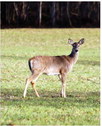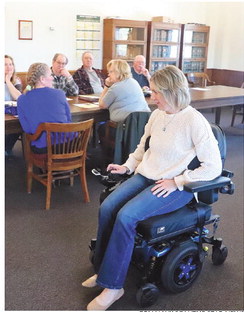Baiting ban set


As expected, the Wisconsin Department of Natural Resources (DNR) has established a ban on baiting and feeding white-tailed deer in response to notification on Aug. 11 from the Wisconsin Department of Agriculture, Trade and Consumer Protection (DATCP) that a farm-raised deer on a deer farm in Taylor County tested positive for chronic wasting disease (CWD).
With this new CWD-detection, Taylor County is now considered a CWD affected county. The ban was announced by the DNR on Friday and went into effect Wednesday, Sept. 1 and will last a minimum of three years.
State law requires that the DNR enact a ban on feeding and baiting deer in counties when a farm-raised or free roaming domestic or wild animal that tests positive for CWD or tuberculosis in the county where detected and any other counties within a 10-mile radius of the positive animal’s known location.
By law, the ban lasts for three years in the county of detection and two years for any other counties within the 10-mile radius. In this case, the Gilman area farm is more than 10 miles from a county border, so the current ban only affects Taylor County. “If there are any other additional positives that come up, whether it’s in wild or farm-raised deer that would essentially re-set that three-year date,” DNR wildlife health conservation specialist Amanda Kamps said Monday. “It could get extended out if additional positives are detected.”
Kamps noted there is also the potential down the road for the ban to be extended under the two-year stipulation if a positive is found within 10 miles of Taylor County’s borders.
The ban pertains only to deer. It does not affect lawful baiting for other species such as bears. The black bear hunting season begins Wednesday, Sept. 8, although in Zone A, which covers Taylor County north of Hwy 64, hunters who use dogs will get the first crack at harvesting bears. Baiters can begin to harvest bears on Sept. 15. Baiting is allowed south of Hwy 64 in Zone C at the start of the season Sept. 8.
The baiting and feeding ban does not cover food plots or farm fields.
“Food plots are different,” Kamps said. “They are not considered bait, like putting a pile of bait out for deer. They are considered something different. They are covering a larger area of land, they’re not continually replaced. With a soybean field, or whatever you have growing, it grows in a season and then it gets eaten. It doesn’t keep growing. With a bait pile, you could put out bait daily. You can keep replenishing that, so there’s differences between food plots versus the baiting and feeding that is being banned.”
State regulations will still allow for scent to be used while hunting deer or other wild animals, but the scent may not be placed or deposited in a manner that is accessible for consumption by deer and scents must be removed daily at the end of hunting hours established for deer, unless two ounces or less of scent is used.
Pat Beringer, the DNR’s area wildlife supervisor for seven northern counties including Taylor, said the agency’s immediate approach to the positive detection starts with an education and surveillance approach.
“In dealing directly with the ban on baiting and feeding, law enforcement will do sort of an educational campaign,” Beringer said. “We’re not just going to go out there and start giving tickets to everybody that’s baiting and feeding. We want to introduce this to the public and let them know the reasoning why we’re doing it and the importance of it. Of course at some point in time, LE will take it to the next level.”
Depending on the offense, violating baiting and feeding bans can result in fines starting from $343.50.
With Taylor County now a CWD-affected county, there are just 17 counties left on the DNR’s current map showing where baiting is still allowed. Neighboring Clark, Price and Rusk are three of those counties. Six counties in the Green Bay area and seven northern counties –– Price, Rusk, Sawyer, Iron, Ashland, Bayfield and Douglas –– are the two largest baiting and feeding blocks remaining.
“My first reaction was a pit in my stomach,” Beringer said of hearing about the positive test. “Unfortunately I can no longer say our area is CWD-free. We were kind of the last holdout, the seven-county area that I supervise had not found CWD in the wild or in any captive facility. I always liked to mention that to folks.
“But we knew that in some point in time we could be faced with this and the reality has struck,” he added. “Now we need to concentrate on detection and try to figure out the extent of the situation. I think everyone in the area and the wildlife biologists when this initially comes out are surprised because, it’s like, ‘now it’s me, now I’m the one that’s going to have to deal with this’ and that sort of thing, but it’s what we do as biologists. Wildlife diseases are an important part of wildlife management and we just go forward with what the experts say to do and move forward from there.”
“Baiting has always been in the fabric of Taylor County,” said Mike Riggle, the chairman of Taylor County’s Deer Advisory Council which sets antlerless harvest quotas and hunting permit levels for the county. “We’re probably one of the biggest baiting stalwart counties that there are. So it’s going to be an adjustment for people. I hope people heed that. There’s a fair number of people out there that bait out of self-defense because their neighbors do. I think what you’re going to see now is those people saying now ‘I’m quitting’ and if the neighbor’s baiting, he’s going to get a visit.”
While many hunters have become accustomed to hunting deer over bait, Beringer and Riggle said it may surprise people what eliminating the practice could do.
“I’ve already gotten some phone calls about what they can do and what they can’t do,” Beringer said. “It’s going to change things. I think there actually are going to be some hunters that are going to be happy to see this occur as well because they feel that deer movements will become more normal with the removal of the artificial feed on the landscape.”
“If you remember back when CWD was first discovered, we had two years where we had no baiting and feeding and I had a lot of people tell me they were seeing a lot of deer,” Riggle said.
Surveillance effort
During the past two hunting seasons, Taylor County was part of a concerted DNR effort for CWD sampling of harvested deer in northwest Wisconsin. The goal was to get about 300 deer sampled in that two-year period in the county, mainly through self-service kiosks. Last November, kiosks were set up in Medford, Rib Lake and Sheldon. That region-wide effort shifts to the northeast this year, but a localized effort will continue in Taylor County, especially on the western side.
“Our goal will be to sample 150 deer within a 10-mile radius of the site where the positive was found,” Beringer said. “We haven’t really set that yet. This is all pretty new. We haven’t created the maps or anything like that yet, but what we’ll do is we’ll be collecting samples in the area from ag damage permits. We will be putting out kiosks for hunters that want to get their deer sampled, they can go to the kiosks and drop off the head and fill out information and we can get them submitted that way.
“We have in the past also worked with processors and taxidermists to get samples, so we’ll be trying those avenues as well with the goal of getting 150 in that 10mile radius,” he said. “A large part of this is going to be education and surveillance to just try to get a handle on what we’re faced with here. Hopefully it will stay within the facility and it’s not in the wild and we can keep it that way.”
Kamps said information on CWD self-service sampling or carcass waste disposal is constantly updated on the DNR website as the hunting season progresses.
“This is more of a target surveillance area,” Kamps said. “We still do want to collect a good number of samples there so we’re doing our due diligence with the sampling around the farm. We do have a CWD sampling page on our website and in the hunt wild app. We have a map that has sampling locations and carcass disposal locations. I know once we get a little bit closer to the start of archery you’ll start seeing more of the locations pop up on the map once our staff get out there, get them set up and ready to go.”
The CWD sampling website is easily accessible by visiting dnr.wi.gov and then searching key words “CWD sampling.”
Riggle hopes the news of the positive detection will spur more people to get their deer tested during the upcoming hunting season, which begins with crossbow and archery hunting on Sept. 18.
“People in Taylor County have had this idea that we don’t want to test because we don’t want to know,” Riggle said. “Well, we’d like to know before it gets so bad that it’s everywhere. You would think it would (result in more tests). I don’t know that that’s going to be the common thread. We’ve had trouble getting heads here before. It’s been a struggle.
“I’m hoping we don’t find one in the wild, but if we do, we do,” he added. “We have to be vigilant now and check that area. It would be so nice if we got ahead of it. You’ve had areas like the one near Rice Lake when they had one and got on top of things, they really did a lot of concentrated testing. They haven’t had a positive since. They got ahead of it and got on top of it.”






